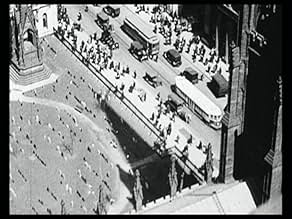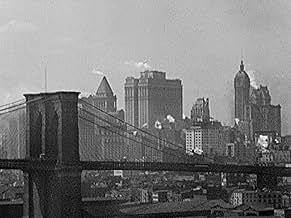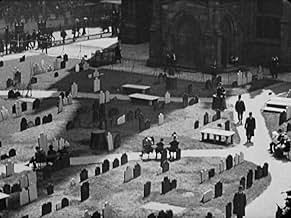IMDb रेटिंग
6.6/10
1.7 हज़ार
आपकी रेटिंग
अपनी भाषा में प्लॉट जोड़ेंThis groundbreaking silent documentary captures the beauty and majesty of the New York City in its streets, skyscrapers, bridges, rail yards and harbors.This groundbreaking silent documentary captures the beauty and majesty of the New York City in its streets, skyscrapers, bridges, rail yards and harbors.This groundbreaking silent documentary captures the beauty and majesty of the New York City in its streets, skyscrapers, bridges, rail yards and harbors.
- निर्देशक
- लेखक
- पुरस्कार
- कुल 1 जीत
फ़ीचर्ड समीक्षाएं
Preface: Due to the nature of such a short film, any valid review will contain some evidence of a "spoiler." This review is no exception.
Paul Strand's "Manhatta" is more than just the simple, pioneering piece in early cinema. "Manhatta" is a representation of New York City through the eyes of a still photographer. Strand uses the format of motion picture to create a sense of life. Similar to his New York still photography, each moving image frames city life, angles, and other objects with semi-avant-garde detail. Strand's own "mentor," Alfred Stieglitz, greatly appreciated the new form of city photography, publishing it in "Camera Work" and in his gallery 291.
In the movie, the blowing smoke, walking people, moving ships, and other objects in motion are what separate the motion picture from a photo album. Instead of portraying New York as an iconic, prosperous city, Strand has been able to portray New York City as an organism that contains a immigrant working class.
In my opinion, "Manhatta" commands the respect of many early motion pictures, influencing many great, more popular films.
Paul Strand's "Manhatta" is more than just the simple, pioneering piece in early cinema. "Manhatta" is a representation of New York City through the eyes of a still photographer. Strand uses the format of motion picture to create a sense of life. Similar to his New York still photography, each moving image frames city life, angles, and other objects with semi-avant-garde detail. Strand's own "mentor," Alfred Stieglitz, greatly appreciated the new form of city photography, publishing it in "Camera Work" and in his gallery 291.
In the movie, the blowing smoke, walking people, moving ships, and other objects in motion are what separate the motion picture from a photo album. Instead of portraying New York as an iconic, prosperous city, Strand has been able to portray New York City as an organism that contains a immigrant working class.
In my opinion, "Manhatta" commands the respect of many early motion pictures, influencing many great, more popular films.
One of the earliest "city symphonies", and arguably one of the most groundbreaking avant garde films of the 1920's, 'Manhatta' is a lyrical, slow, and moving tribute to a great American city based loosely off of a Walt Whitman poem. The imagery isn't as intense and vibrant as that in many other films of a similar nature, whether they be other city symphonies or just other avant garde/experimental films in general, but there are several shots in here that definitely widened my eyes. The very specific positioning of the camera for certain angles helped give much of the short film a very epic feel. At some points, it even felt extremely futuristic and, to me, evoked some shots from Fritz Lang's legendary classic 'Metropolis'. It's only about twelve minutes, so any fan of experimental film might as well check it out as it is highly revolutionary and visually pleasing.
Here's the beginning of the city symphony film, which would include "Berlin: Symphony of a City" (1927) and "The Man with a Movie Camera" (1929). Although "Manhatta" doesn't contain the rapid rhythmic montage of some of the later city symphonies, it does have a sort of slower, poetic rhythm to it. It's discernible from a travelogue in that it has something to say about its city, other than it's a nice place to visit. The steady progression of images interloped with poetic intertitles taken from Walt Whitman produce the rhythm.
From the still photographer Paul Strand and the painter and still photographer Charles Sheeler, their view of Manhattan is, of course, modern. The shots are of skyscrapers and the inter-workings of the city. One is Strand's 1915 still photograph "Wall Street" come to motion. The composition, camera placement and observation of light and shadow are striking throughout the short film, and they are reflective of the work by the filmmakers in other media. Sheeler and Strand had already transplanted modern, abstract and formal ideas from painting into still photography and with "Manhatta" they similarly redirected film.
From the still photographer Paul Strand and the painter and still photographer Charles Sheeler, their view of Manhattan is, of course, modern. The shots are of skyscrapers and the inter-workings of the city. One is Strand's 1915 still photograph "Wall Street" come to motion. The composition, camera placement and observation of light and shadow are striking throughout the short film, and they are reflective of the work by the filmmakers in other media. Sheeler and Strand had already transplanted modern, abstract and formal ideas from painting into still photography and with "Manhatta" they similarly redirected film.
MANHATTA is an unusual short film. It's like the merging of a travelogue with a poem. So, as the camera moves artistically about the city of New York, the scenes are punctuated with intertitle cards that have poetic verse on them that make it all seem grand and majestic.
While much of this won't appeal to most viewers, the film is still worth seeing for two important reasons. First, the short is a wonderful historical record of the city. In other films of the era, New York is incidental, in a way. You might see bits and pieces of the city, but the city is not the star. Here, however, you see so much of the town that you wouldn't see otherwise--and much of it is gone today. Second, the film is very artistic in its cinematography--with wonderful aerial shots as well as nicely frames shots of the Brooklyn Bridge and the like.
Perhaps not exciting, but a rather important document. And, despite the original negatives being missing and only one print in existence until it was restored, the print looks great!
While much of this won't appeal to most viewers, the film is still worth seeing for two important reasons. First, the short is a wonderful historical record of the city. In other films of the era, New York is incidental, in a way. You might see bits and pieces of the city, but the city is not the star. Here, however, you see so much of the town that you wouldn't see otherwise--and much of it is gone today. Second, the film is very artistic in its cinematography--with wonderful aerial shots as well as nicely frames shots of the Brooklyn Bridge and the like.
Perhaps not exciting, but a rather important document. And, despite the original negatives being missing and only one print in existence until it was restored, the print looks great!
This short film by Sheeler and Strand is the father of American avant-garde cinema.
It contains beautiful shots of Manhattan shown intertwined with excerpts of a Walt Whitman poem. All of the shots are thought out, and very photographic in nature. But that is expected with Paul Strand behind the camera.
This film is probably the first American avant-garde film, and if it isn't, it is definitely the first influential avant-garde film. A guideline for future American avant-garde filmmakers to follow.
A true visual treat, even for today's standard.
It contains beautiful shots of Manhattan shown intertwined with excerpts of a Walt Whitman poem. All of the shots are thought out, and very photographic in nature. But that is expected with Paul Strand behind the camera.
This film is probably the first American avant-garde film, and if it isn't, it is definitely the first influential avant-garde film. A guideline for future American avant-garde filmmakers to follow.
A true visual treat, even for today's standard.
क्या आपको पता है
- ट्रिवियाThe poet whose works are quoted during the film is Walt Whitman.
- भाव
Title Card - Walt Whitman: "City of the world - for all races are here, City of tall facades of marble and iron, Proud and passionate city."
- इसके अलावा अन्य वर्जनThis film was published in Italy on an DVD anthology entitled "Avanguardia: Cinema sperimentale degli anni '20 e '30", distributed by DNA Srl. The film has been re-edited with the contribution of the film history scholar Riccardo Cusin . This version is also available in streaming on some platforms.
- कनेक्शनFeatured in The Secret Life of Sergei Eisenstein (1987)
टॉप पसंद
रेटिंग देने के लिए साइन-इन करें और वैयक्तिकृत सुझावों के लिए वॉचलिस्ट करें
विवरण
- चलने की अवधि11 मिनट
- रंग
- ध्वनि मिश्रण
- पक्ष अनुपात
- 1.33 : 1
इस पेज में योगदान दें
किसी बदलाव का सुझाव दें या अनुपलब्ध कॉन्टेंट जोड़ें




















